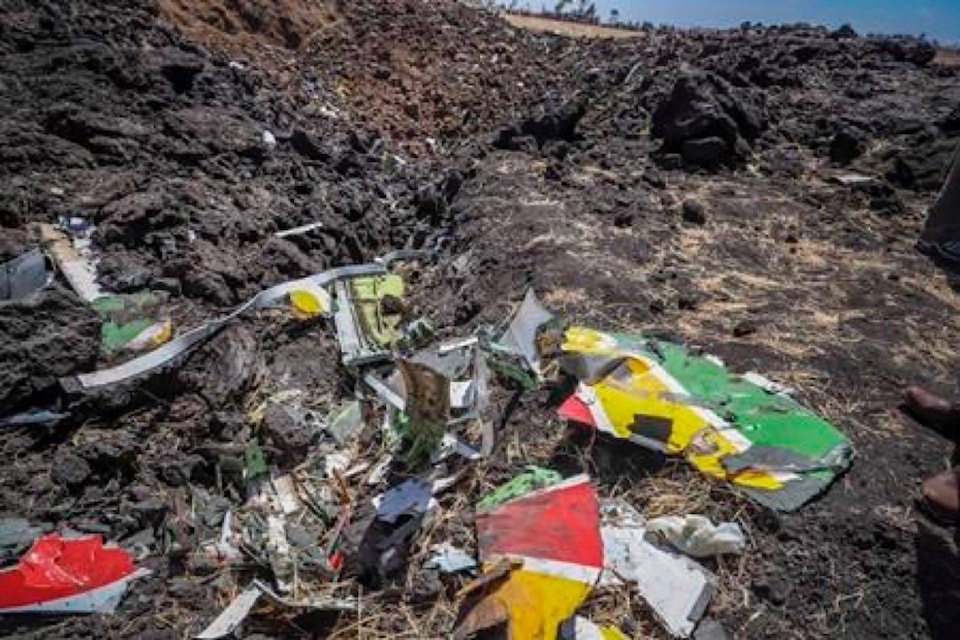Investigators are trying to determine the cause of a deadly crash Sunday involving a new aircraft model touted for its environmentally friendly engine that is used by both Air Canada and WestJet.
Eighteen Canadians were among the 157 passengers and crew who died when an Ethiopian Airlines plane went down shortly after departing from Bole Airport in Ethiopia’s capital Addis Ababa en route to Nairobi, Kenya.
The Boeing 737 Max 8 was new and had been delivered to the airline in November, records show.
The aircraft was also involved in a Lion Air crash in October when a two-month-old plane plunged into the Java Sea minutes after taking off from Jakarta, Indonesia’s capital, killing 189 people.
It was not clear what caused the plane to go down in clear weather, but the pilot sent out a distress call and was given clearance to return, the airline’s CEO said on Sunday.
Air Canada has 24 Boeing 737 Max 8 planes in its fleet and WestJet operates 13.
“Our thoughts and prayers are with the families and friends of the passengers and crew of Ethiopian Airline Flight 302 which was lost while enroute to Nairobi this morning,” Air Canada spokeswoman Isabelle Arthur said in a statement. “These aircraft have performed excellently from a safety, reliability and customer satisfaction perspective.”
WestJet also expressed condolences, and said it would not speculate on the cause of the incident at this time.
Boeing said it was “deeply saddened” to learn of the crash.
“We extend our heartfelt sympathies to the families and loved ones of the passengers and crew on board and stand ready to support the Ethiopian Airlines team,” it said in a statement.
A Boeing technical team will be travelling to the crash site to provide technical assistance, working with Ethiopian authorities and the U.S. National Transportation Safety Board.
Indonesian investigators have not determined a cause for the October crash there, but days after the accident Boeing sent a notice to airlines that faulty information from a sensor could cause the plane to automatically point the nose down. The notice reminded pilots of the procedure for handling such a situation.
Data from a preliminary investigation report, which didn’t state any conclusions, showed that the plane’s nose pointed down 26 times on its fatal 11-minute flight despite repeated efforts by the pilots to manually aim the nose higher.
Aviation expert and lawyer Arthur Rosenberg said investigators are just starting to gather information about the Ethiopia crash, but it’s likely that the same system implicated in the Lion Air crash is involved in this one.
“Based on that photograph, that impact crater that I saw, this plane pretty much just came straight down,” he said. “It looks like this crew didn’t really have much time to respond.”
The selling feature of the 737 Max 8 is that it is similar to older models, so flight crews would not need a lot of retraining, Rosenberg said. When the plane senses an imminent stall it pushes the nose down, and most pilots would react by pulling back on the control yoke, he said. But on this model it doesn’t stop the nose dive — instead, two toggle switches on the centre console are the only way to override the system, Rosenberg said.
“There’s just no time, (or) situational awareness to recognize what’s going on and to take the appropriate action,” Rosenberg said. “These are complex machines being piloted by human beings and I don’t care how great a pilot you are, it takes time to process this information.”
The jetliner showed unstable vertical speed after takeoff, air traffic monitor Flightradar 24 said in a Twitter post.
Ethiopian Airlines has a really good reputation and is known as a state-of-the-art airline, Rosenberg added.
Safety experts cautioned against drawing too many comparisons between the two crashes until more is known about Sunday’s disaster.
The Ethiopian Airlines CEO “stated there were no defects prior to the flight, so it is hard to see any parallels with the Lion Air crash yet,” said Harro Ranter, founder of the Aviation Safety Network, which compiles information about accidents worldwide.
Ethiopian Airlines said Ethiopian authorities, manufacturer Boeing and other international stakeholders will collaborate on an investigation
The jet’s last maintenance was on Feb. 4, and it had flown just 1,200 hours. The pilot was a senior aviator, joining the airline in 2010, the CEO said.
Meanwhile, a spokesman says Ethiopian Airlines has now grounded all its Boeing 737 Max 8 aircraft as a safety precaution.
Asrat Begashaw said Monday that although it is not yet known what caused the crash on Sunday, the airline decided to ground its remaining four 737 Max 8 planes until further notice as “an extra safety precaution.” Ethiopian Airlines was using five new 737 Max 8 planes and was awaiting delivery of 25 more.
China’s civilian aviation authority also ordered all Chinese airlines to ground their Boeing 737 Max 8 planes indefinitely on Monday.
The Civil Aviation Administration of China said the order, issued Monday morning, was “taken in line with the management principle of zero tolerance for security risks.”
It said further notice would be issued after consultation with the U.S. Federal Aviation Administration and Boeing on safety measures taken.
Eight Chinese nationals were among those killed in Sunday’s crash.
— With files from The Associated Press
